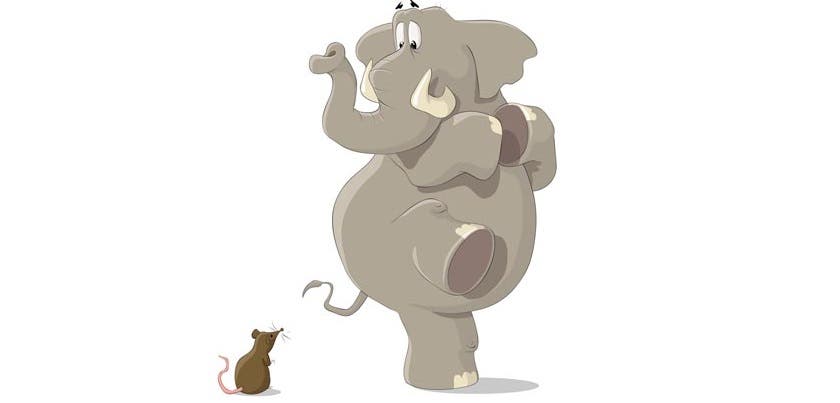From Saturday morning cartoons to old fables, one of the most iconic images is that of an elephant cowering in front of a mouse. This conjuring is often used as an allegory for the underdog, but is there any truth to it?
An ancient myth: where did the idea of elephants being afraid of mice come from?
It’s not clear where or when the first ‘elephant scared by a mouse’ myth started. One version can be traced back to 77 AD, the time of Pliny the Elder — who, next to Aristotle, was probably the most influential scholar in antiquity.
Pliny was the first to say “The elephant hates the mouse above all other creatures,” and because he was so influential and highly regarded, this sort of stuck — and not only with the Romans. This anecdote then wove its way into folklore, later infiltrated children’s books, and even found its way into cartoons, notably the Tom and Jerry series.
Remember, elephants didn’t live in the so-called ‘civilized’ Western world. So, like other exotic species, their appearance and behavior were left to the imagination. Just look at how people used to think elephants looked like in the Middle Ages — totally hilarious.

But as the myth spread, it began to dawn on some educated people the ridiculousness of a three-ton-animal petrified by a teeny-weeny mouse. These critical thinkers included Allen Moulin who was an Irish physician during the 1600s.
Moulin, who wasn’t at all familiar with elephants but at least had some knowledge of their anatomy from the limited academic papers of his time, offered a seemingly sensible explanation. He reasoned that since elephants lack epiglottis — a cartilage that protects the windpipe while swallowing — one may assume that such a large creature could be afraid of a tiny one if the latter could crawl up the elephant’s trunk and suffocate it.
Alas, like Pliny before him, Moulin wasn’t really on to anything. He did, however, perpetuate a seemingly scientific explanation for why the biggest land mammal in the world is afraid of mice.
Like any wildlife biologist will tell you today, elephants do actually have that flappy cartilage to protect their windpipes. Even if a mouse, insect, or any kind of ‘debris’ ended up in the trunk, the elephant needs only to blow it. In fact, that’s what they do most of the time when they feel their trunk is getting clogged.
Let’s ask the Myth Busters
Back in 2006, in an episode of Myth Busters, Adam Savage and Jamie Hyneman found the myth was actually ‘plausible’.
In the experiment, an elephant was walking along a designated path. The team introduced a mouse along the route, hidden under a pile of dung. As the elephant neared the pile, the mouse was released.
Though they didn’t give it any chance initially, their experiments suggest that South African elephants stopped dead in their tracks when they were met by mice hidden in dung.
Once the elephants noticed the little critters, they actually backed away and even started moving in the other direction.
However, the elephant didn’t exhibit signs of fear or distress. Rather, the elephant seemed to exhibit caution, avoiding a potential disturbance in its otherwise calm stroll.
I would point out that this was a small and informal experiment. The same can be said about the same segment done on another popular TV show, ABC’s 20/20. The 20/20 host reached out to a local circus where Troy Metzler, a certified elephant trainer, let the production team show one of his elephants a white mouse. The little rodent was then shown to other elephants, none of whom seemed to notice the mouse.
Myth versus science
According to John Hutchinson, who is a researcher at the Royal Veterinary College in London, elephants in the wild get nervous whenever a small but fast animal meets their tracks. That means that not only mice can disturb them, but also dogs, cats, and just about anything that’s agile.
What’s also important to note is that elephants don’t have very good eyesight. They also have a blind spot directly in front of them extending up to a few feet, so a mouse zipping through right in front of their legs wouldn’t even be detected.
There’s also something to be said about the novelty factor may. In the heat of the African savannah or the dense foliage of the Indian forests, it’s rather unlikely that an elephant would have any significant encounter with a mouse. Captive elephants, like those in zoos or circuses, are often seen sleeping with rodents right on top of them. They seem to mind them very little, as most zoo keepers would tell you.
So, rather than being afraid of mice per se, elephants seem to be startled by frantic movements. But, really, the same can be said about any animal living in the wild.
Elephants, despite their immense size, are gentle and cautious beings. They are known to avoid stepping on smaller creatures and may even go out of their way to avoid disturbing them. It’s highly unlikely that any elephant in the world is afraid of mice, but it would be more correct to say that some are merely cautious and considerate around them.
In light of scientific evidence and expert insights, it’s safe to conclude that elephants are not inherently afraid of mice. This age-old myth likely originated from the elephants’ cautious and empathetic nature being misunderstood as fear.







